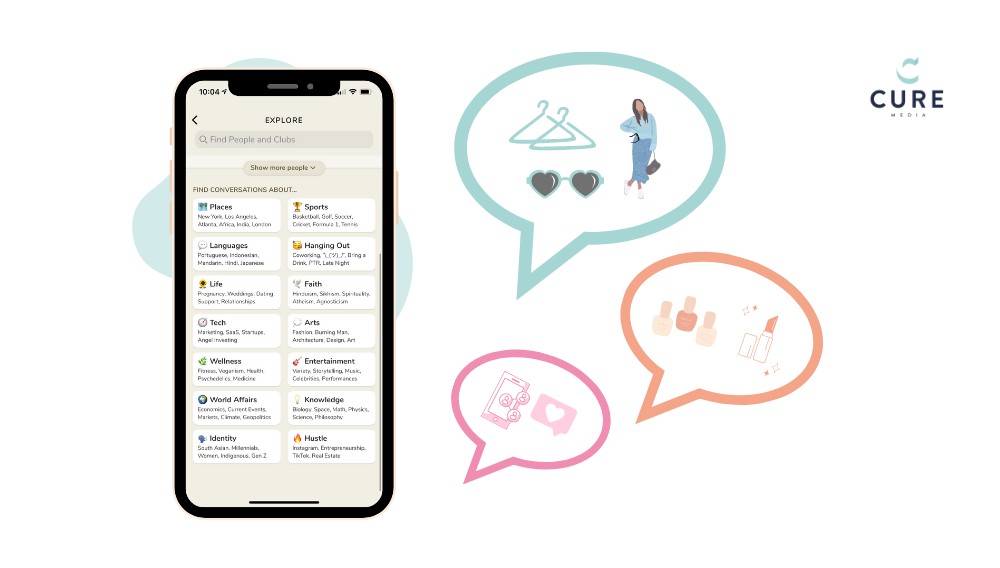Everyone is talking about Clubhouse, the new social network centred around user-generated audio conversations. But what’s the real deal with this fast-growing app? In this article, we’ll walk you through the low-down on the most common questions about Clubhouse; who the users are, how brands can use it today, and of course, where we think its future lies.
What is Clubhouse?
Clubhouse is the newest platform to join the social media scene and can be described as an exclusive, invite-only audio app where participants can move around virtual rooms to discuss from culture and art, to TikTok marketing and space travels with Elon Musk. It was initially launched in April 2020 as a space for people to network all over the world, and gained popularity in the early months of the Covid-19 pandemic. It’s still in beta mode, but it’s growing at a rapid pace as more and more users are being invited to the app. As of February 2021, the app is valued at 100 million USD.
How does Clubhouse work?
Clubhouse labels itself as “drop-in audio chat” and the idea is not completely new, but reminds us of the chat rooms of the early internet. Instead of instant messaging though, it’s real-time audio – like a live podcast where everyone can listen in and join the conversation. So how does it work? Any member can start a virtual “room” that other users can join. Each room has moderators, speakers and listeners. Moderators control who gets to speak, and listeners can “raise their hand” to request to speak. In other words, Clubhouse is taking virtual events to the next level and we’re excited to see what’s more to come!
Who uses Clubhouse today?
In January 2021, only nine months after the launch of the app, Statista reported that the audio-based social network has over two million weekly active users.
Yet, there isn’t much detailed data on Clubhouse users; who they are and how much time they spend on the social network. But according to users talking about their own time-spend on the app, active users tend to spend several hours. What speaks in favour of this high time-spend is the availability of the audio-format – it’s easy to tap in and listen to a conversation without having to be presentable (as with video) or the need to contribute with anything to say yourself.
Fun fact! According to Influencer Marketing Hub, one of the founders of Clubhouse has been known to head into rooms to ask for feedback on the app and its features.
How Can Brands Use Clubhouse?
As the heart of Clubhouse is people talking to each other, it is a great social platform for brands to build relationships with their target audience. For example, as a fashion brand, you could host a conversation around the biggest summer fashion trends with an expert or an influencer within this niche. As a beauty brand, you could host a conversation around how to take care of your winter skin and let people ask live questions to a skin therapist. We spot that the key for brands on Clubhouse is to build a community, share knowledge and discuss current topics within their industry.
A great way is also to gain feedback from existing customers. According to Cure Media’s annual survey, 44% of marketers struggle with improving customer experience. With Clubhouse, marketers can find a great opportunity to ask what their customers think of e.g. your products, deliveries, or CSR-questions. It’s a great way to involve customers and make them a part of this valuable conversation that most often only happens internally with hard-to-get customer feedback.

What does Clubhouse Future Look Like?
Clubhouse is centred around its user-generated content and this is also where the future of the app relies on – users creating interesting conversations and topics. Its content is happening live and as a user you need to tap in and listen directly when you get notified of a conversation or speaker that seems interesting. With this, each conversation gains a feeling of exclusivity for participants and a FOMO-feeling (Fear Of Missing Out) which might have an appeal to users also in the future.
Worth mentioning that no conversations are recorded within the app. This means that it’s not possible to listen to what’s been said after the conversation has taken place. That is, if no user has recorded it themselves. This actually happened when a Clubhouse conversation with Elon Musk reached its maximum limit of participants and one user live-streamed the conversation on YouTube. Maybe recorded conversations will be available in the future, who knows?
Another benefit with Clubhouse is that you can get in touch and talk to people you otherwise would not have access to. This feature makes Clubhouse great for career networking within a niche topic, similar to LinkedIn.
What is important to think about as a marketer?
Even though Clubhouse isn’t yet the most obvious channel for brands, it is a great idea to keep an eye on this popular platform. The digital media landscape changes fast, and it’s important to keep up and continuously evaluate what channels and strategies to use to remain relevant for your target group. In the short run, Clubhouse is mostly of interest for brands to raise awareness and share knowledge within their area of profession, e.g beauty or influencer marketing. In the long term, we’re looking forward to seeing in which direction Clubhouse will lead its users!
There’s a lot to say about Clubhouse and we’re excited to see how the platform evolves during the year ahead, but we hope we’ve been able to provide you with a good overview. If you want to continue the conversation around the role of social media, we recommend you to check out our podcast to stay updated with the latest influencer marketing and social media trends.



